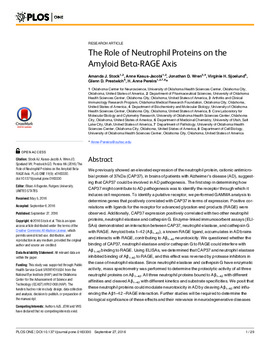| dc.contributor.author | Amanda J. Stock | |
| dc.contributor.author | Anne Kasus-Jacobi | |
| dc.contributor.author | Jonathan D. Wren | |
| dc.contributor.author | Virginie H. Sjoelund | |
| dc.contributor.author | Glenn D. Prestwich | |
| dc.contributor.author | H. Anne Pereira | |
| dc.date.accessioned | 2017-03-05T23:40:58Z | |
| dc.date.available | 2017-03-05T23:40:58Z | |
| dc.date.issued | 2016-09-27 | |
| dc.identifier.citation | Stock AJ, Kasus-Jacobi A, Wren JD, Sjoelund VH, Prestwich GD, Pereira HA (2016) The Role of Neutrophil Proteins on the Amyloid Beta-RAGE Axis. PLoS ONE 11(9): e0163330. doi:10.1371/journal.pone.0163330 | en_US |
| dc.identifier.uri | https://hdl.handle.net/11244/49295 | |
| dc.description | We would like to thank Dr. Arthur Owora, previously a Research Biostatistician of the Department of Pharmaceutical Sciences, University of Oklahoma Health Sciences Center, for his assistance on the statistical analysis performed in this study. We thank Dr. Sixia Chen of the Department of Biostatistics and Epidemiogy, University of Oklahoma Health Sciences Center, for his additional input on the statistical analysis. We thank the Laboratory for Molecular Biology and Cytometry Research at the University of Oklahoma Health Sciences Center for the use of the Core Facility which allowed us to perform the MALDI-TOF MS and MS/MS experiments. GM-0111 was provided as a gift by Dr. Justin Savage, GlycoMira Therapeutics, Inc. | en_US |
| dc.description | | en_US |
| dc.description.abstract | We previously showed an elevated expression of the neutrophil protein, cationic antimicrobial protein of 37kDa (CAP37), in brains of patients with Alzheimer’s disease (AD), suggesting that CAP37 could be involved in AD pathogenesis. The first step in determining how CAP37 might contribute to AD pathogenesis was to identify the receptor through which it induces cell responses. To identify a putative receptor, we performed GAMMA analysis to determine genes that positively correlated with CAP37 in terms of expression. Positive correlations with ligands for the receptor for advanced glycation end products (RAGE) were observed. Additionally, CAP37 expression positively correlated with two other neutrophil proteins, neutrophil elastase and cathepsin G. Enzyme-linked immunosorbent assays (ELISAs) demonstrated an interaction between CAP37, neutrophil elastase, and cathepsin G with RAGE. Amyloid beta 1–42 (Aβ1–42), a known RAGE ligand, accumulates in AD brains and interacts with RAGE, contributing to Aβ1–42 neurotoxicity. We questioned whether the binding of CAP37, neutrophil elastase and/or cathepsin G to RAGE could interfere with Aβ1–42 binding to RAGE. Using ELISAs, we determined that CAP37 and neutrophil elastase inhibited binding of Aβ1–42 to RAGE, and this effect was reversed by protease inhibitors in the case of neutrophil elastase. Since neutrophil elastase and cathepsin G have enzymatic activity, mass spectrometry was performed to determine the proteolytic activity of all three neutrophil proteins on Aβ1–42. All three neutrophil proteins bound to Aβ1–42 with different affinities and cleaved Aβ1–42 with different kinetics and substrate specificities. We posit that these neutrophil proteins could modulate neurotoxicity in AD by cleaving Aβ1–42 and influencing the Aβ1–42 –RAGE interaction. Further studies will be required to determine the biological significance of these effects and their relevance in neurodegenerative diseases such as AD. Our findings identify a novel area of study that underscores the importance of neutrophils and neutrophil proteins in neuroinflammatory diseases such as AD. | en_US |
| dc.language.iso | en_US | en_US |
| dc.publisher | PLos One | |
| dc.relation.ispartofseries | PLoS ONE 11(9): e0163330 | |
| dc.relation.uri | http://www.plosone.org/article/info%3Adoi%2F10.1371%2Fjournal.pone.0163330 | |
| dc.rights | Attribution 3.0 United States | |
| dc.rights.uri | https://creativecommons.org/licenses/by/3.0/us/ | |
| dc.subject | Neutrophils,Protease inhibitors,Alzheimer disease,Binding analysis,Protein interactions,Mouse models,Neurons,Matrix-assisted laser desorption ionization time-of-flight mass spectrometry | en_US |
| dc.title | The Role of Neutrophil Proteins on the Amyloid Beta-RAGE Axis | en_US |
| dc.type | Research Article | en_US |
| dc.description.peerreview | Yes | en_US |
| dc.description.peerreviewnotes | http://www.plosone.org/static/editorial#peer | en_US |
| dc.identifier.doi | 10.1371/journal.pone.0163330 | en_US |
| dc.rights.requestable | false | en_US |

